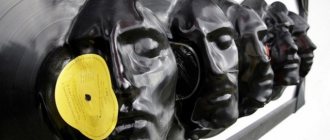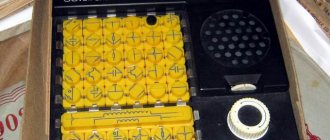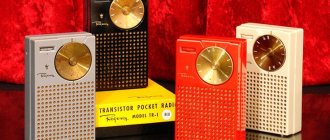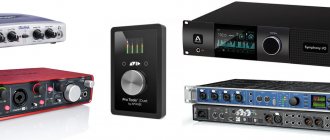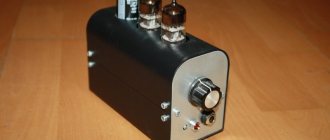The request for "Stereo" is redirected here; see also other meanings.
Stereophony
[1] or
Stereo sound
(from the ancient Greek στερεός
“stereos”
- “solid, spatial” and φωνή - “sound”) - a method of recording and reproducing sound, which creates the illusion of “sound perspective” while maintaining directions to different sources sound. This is achieved through the use of the binaural effect and the simultaneous transmission of sound information through two or more independent channels, in contrast to monaural sound transmission, when sound is transmitted through a single channel.
In everyday life, stereophonic
It is customary to call two-channel sound recording, but this concept covers a wider scope, denoting surround sound with any number of channels. The term “stereophony” equally applies to such concepts as “quadraphony” and “surround sound”. When playing a stereo recording through a single speaker, the sound quality is reduced due to the interference of signals from different channels that differ in phase.
Types of stereophony
There are two fundamentally different ways to produce a stereo recording. In the first, two or more microphones are used to record the sound field, spaced at a certain distance from each other. The pulsating audio frequency current created by each of the microphones is amplified by separate amplifiers independent of each other and recorded on separate media channels. During playback, the sound received from each of the microphones is amplified independently and sent to separate speakers or speaker systems positioned according to the placement of the microphones. In this way, the sound picture that existed at the time of recording is recreated. The ideal way to reproduce a sound field is considered to be a conventional plane consisting of infinitesimal speakers transmitting sound from microphones located in the same way. In the sound recording of musical works, to obtain a stereo effect, the presence of two independent channels is considered sufficient, and in cinema there should be no less than three of them in order to exclude a “dip” in the center of the sound picture, corresponding to the middle of the screen. Thus, in the wide-screen cinematographic systems "Cinemascope" and "Wide Screen" three front channels were used, and in the wide-screen systems "Todd-AO" and "NIKFI" - five[2][3].
The second method is called pseudostereo.
, and unlike the first one does not require several microphones to record the sound field.
A stereophonic soundtrack is created by distributing several original monophonic recordings over different channels ( see Multi-track recording
) using a “panoramic mixer”[4]. When creating pseudo-stereophonic phonograms, different sound sources are recorded separately or separate microphones are installed for them. Then, during the mixing process, the received signals are distributed among the channels of the finished phonogram. In this case, the effect of localizing sound sources is created both by adjusting the recording level in different channels and by correcting the frequency response, since it is known that high frequencies have the greatest effect on the illusion of direction. In addition, the effect is further achieved by adjusting the intensity of the reflected sound and the degree of delay using delay lines.
In the 1960s, the United States often practiced the release of so-called “duophonic” gramophone records, in which initially monophonic recordings were given a stereo effect. The mono recording was distributed over two channels with simultaneous correction of the frequency response. In the channel corresponding to partial sound localization, high frequencies were emphasized, while in the opposite channel they were suppressed while maintaining the level of low-frequency signals. After this, the sound in one of the channels was delayed for a fraction of a second, thus creating a false echo effect. Record companies did this with single-channel recordings made before the introduction of stereo technology (Elvis Presley, Frank Sinatra records), or for some technical reason recorded on a single-channel system, despite the possibility of stereophony (The Beatles[* 1], The Beach Boys; so called fake stereo
).
In cinema
In film, pseudo stereophony replaced multichannel source recording in the early 1960s, due to the technological complexity of synchronous filming. In Hollywood, multiple microphone arrays were abandoned in 1958, and in the USSR this technology was declared obsolete in 1968; One of the last Soviet wide-format films, the soundtrack of which was recorded with five-channel stereo microphones, was the film “War and Peace”[5]. Subsequently, the original phonogram was recorded with single-channel tape recorders, followed by distribution across channels using a panoramic mixer; For this purpose, at the Mosfilm film studio, a stereo dubbing console with a panoramic control was designed.[6]
The American pseudo-stereophonic sound reproduction system "Perspect" was based on automatic switching of a single audio track to different speakers. To do this, additional control signals with frequencies of 30, 35 and 40 Hertz, which were not reproduced by the amplifier, were recorded in the phonogram. The signals from each frequency were connected to the corresponding loudspeakers located behind the screen of the Vistavision cinemas, creating the effect of sound following the image.[7]
On the radio
In FM broadcasting, the presence of a so-called pilot tone at 19 kHz is an indication of a stereo signal being transmitted. The second harmonic frequency of 19 kHz (38 kHz) isolated in the radio receiver is used as a reference frequency for complete restoration of the stereo signal.
Deception that looks like the truth
Is there any way to achieve stereophonic sound reproduction? Of course you can. To do this, it is enough to install several microphones on stage, in the room where the program is broadcast, place loudspeakers in the same order, each of which is connected to the corresponding microphone. With such a system, the loudspeakers will almost exactly reproduce the sound picture that exists on stage.
Multichannel stereophony has found application, for example, in panoramic cinema, which uses nine sound channels. The sound is recorded using nine groups of microphones onto tape.
When a film is shown, this soundtrack is reproduced by a special nine-channel tape recorder and nine groups of loudspeakers located in different places in the auditorium. The four-channel system used in widescreen cinema is simpler, but it produces amazing stereo effects.
However, neither one nor the other system is practically unsuitable for wire broadcasting, radio broadcasting and sound recording on a record. Indeed, even with a four-channel system, broadcasting stereo broadcasts requires four pairs of wires or four radios. Moreover, four radio receivers are needed to receive such transmissions.
A recording enthusiast would have to play four records at once, and they should spin at exactly the same speed. Being 0.0001 seconds late is no longer acceptable.
Such complications are almost completely unacceptable and, obviously, based on this, many radio specialists believed that for a wide range of radio listeners and record lovers, stereophony is an unaffordable luxury.
Several years ago, attempts began to artificially create at least some semblance of stereo sound in mass radio equipment - receivers, radios, televisions.
This is how surround sound acoustic systems appeared, currently used in the vast majority of domestic receivers and radios. ,In these receivers, the speakers are located not only on the front wall of the box, but also on the two side ones, so it seems that the sound is coming from more than one point.
Pseudo-stereophonic installations have become widespread abroad, in which loudspeakers are placed in two separate boxes located at a considerable distance from one another.
In an amplifier, using special filters, high and low frequencies are separated and fed to different speakers. As a result, on one side of the room you hear low sounds, which mainly correspond to basses and instruments such as drums, double bass, cello, and from the other side you hear high and clear sounds of flutes and violins, and women’s voices.
Such artificial “placement” of individual performers in space, although it creates some semblance of stereophony, but, of course, has nothing in common with what you would hear if you were in the auditorium.
In fact, if the subwoofer is located to your right, then you will always hear the voice of the bass singer singing on the right, although at that time he may be on the left side of the stage and even move along it from one stage to another.
But if multichannel stereophony is the only possible way to obtain high fidelity sound reproduction, then is it not possible to simplify stereophonic systems and make them accessible for implementation in mass radio equipment? It turns out that it is possible.
As numerous studies by Soviet and foreign specialists have shown, stereophonic transmission can be achieved using three or even two channels. This was confirmed by experiments, in particular those conducted back in 1935 by Prof. I. E. Goron in Moscow at the State Sound Recording Laboratory.
True, with two-channel transmission, the reproduced sound differs somewhat from the real sound picture, but it is not far from the truth. But, having limited ourselves to two channels, we can already think about mass-produced stereophonic equipment.
Development of the stereo format
The principle of stereophony was first put into practice in 1881 in Paris by Clement Ader. On the stage of the Paris Opera, Ader placed a number of telephone translators, the signal from which went through wires to the booths of the Paris Electrical Exhibition. Visitors to the booths could hear the concert live via two handsets (for each ear).
Subsequently, commercial production of two-channel telephones began: in 1890-1932. in France under the name "Théâtrophone", in 1895-1925. in the UK under the name "Electrophone"; they did not have mass distribution.
In sound recording, the first attempts at stereophony were carried out in the early 1930s. The inventions of the English engineer Alan Blumlein made a great contribution to the development of stereophony. His stereo pair of microphones (“Blumlein pair”) is still used in sound recording practice to this day. It consists of two closely spaced bidirectional microphones oriented at right angles to each other. In 1931, he and his colleagues created a test film called "Walking And Talking" using stereo sound, and in 1935 he contributed to the short film "Trains at Hayes", which is the first film in history with stereo sound.[8] .
In March 1932, a recording was made at the Philadelphia Academy of Music using two microphones, the signal from which was sent to two needles, which cut two separate grooves on the same wax disk. The first of these recordings, made on March 12, 1932 (during the performance of “Prometheus” by Alexander Scriabin), is the earliest stereophonic recording that has survived to this day. The first stereo record in history was released in 1933 by EMI: two separate channels were placed on both sides of the groove. In 1940, the first full-length animated film “Fantasia” was created with a pseudo-stereophonic three-channel soundtrack. The recording was played back using the Phantasound system from a separate film. However, due to the extreme complexity of the system and the weakly expressed stereo effect, it did not receive further development[9].
In February 1954, RCA Victor studios made stereo recordings using multi-channel equipment: the performance of the Boston Symphony Orchestra was recorded simultaneously on both mono and two-channel tape. Several more similar recordings followed, but they were not intended for release on records, since there was no market for mass stereo sound reproduction equipment yet. However, a year later, in 1955, the first stereo tape recorders appeared and the production of stereo reels began. Since 1957, the stereo recording process has become prevalent in the American music industry.
Westrex in 1958.
, which made it possible to cut stereo discs, from which it was finally possible to replicate ordinary gramophone records (it was Western Electric that coined the words “
stereo
”, “
stereophonic
” in the field of sound recording). The first commercial stereo record was released that same year. However, until the end of the 1960s. a significant number of records were released in mono sound, despite studio stereo recording.
Through one radio station
Just as a stereophonic recording can be made on a single record, a two-channel stereo radio broadcast can be carried out through a single radio station.
Using one of the common types of modulation, amplitude, you can force the high-frequency current to separately “imprint” each of the two stereo channels, but in such a way that it is easy to separate them in the receiver.
To do this, positive half-cycles of the high-frequency current are modulated by one channel, and negative half-cycles by the second.
But such bipolar modulation is not so easy to implement. The fact is that with amplitude modulation, both positive and negative half-cycles of the high-frequency current change to the same extent and the graph of the modulated signal is practically symmetrical relative to the time axis.
This is the nature of modulation, and here, as they say, nothing can be done. However, it is possible to outwit nature by taking two identical high-frequency currents, but modulating each of them separately with one of the channels.
Here, using semiconductor diodes that pass current only in one direction, it is necessary to “cut off” the negative half-cycles of the first signal, and the positive half-cycles of the second, and, finally, add both modulated signals in a common electrical circuit.
As a result of all these operations, we will get the “hybrid” we need - high-frequency current, separately modulated by each of the stereo channels.
In the receiver, these channels can be easily separated using the same semiconductor diodes. One of them will skip only the positive half-cycles, and the second - the negative ones, and thus the stereo channels will again be separated.
This is approximately how stereo transmission is carried out through one radio station, and reception is carried out using one receiver. Of course, such a receiver, just like a stereo tape recorder or player, must have two low-frequency amplifiers with loudspeakers.
One such amplifier is in the receiver itself, and the second, together with a detector that separates the channels, can be made in the form of a small and relatively simple attachment.
Quadrophony
Quadrophony
(from Latin quattuor - four and other Greek φωνή - sound) - a type of stereophony that uses 4 independent channels. Unlike two-channel stereo sound, which forms a panorama in front of the listener, quad sound is designed to surround the listener on 4 sides and create a feeling of his presence “inside the sound.” Quad speakers, like microphones, are placed in the corners of the room, but other locations are possible, for example in the center of the walls. Quadro had limited success in the 60-80s of the last century, but it did not take off commercially, primarily due to the cost of the equipment, and also, as a consequence, the low demand for multi-channel audio media. Today, interest in quad is being revived due to the prevalence of multi-channel audio formats (5.1).
- 5.1
- Dolby Digital
Literature
- M. Z. Vysotsky.
Cinema systems and stereo sound / Eisymont L. O. - M.: “Iskusstvo”, 1972. - P. 122-124. — 336 p. — 3500 copies.
- E. M. Goldovsky.
Fundamentals of film technology / L. O. Eisymont. - M.,: “Iskusstvo”, 1965. - 636 p.
- I. B. Gordiychuk, V. G. Pell.
Section I. Cinematography systems // Cinematographer’s Handbook / N. N. Zherdetskaya. - M.,: “Iskusstvo”, 1979. - P. 25-34. — 440 s.
- B. N. Konoplyov.
Fundamentals of film production / V. S. Bogatova. - 2nd ed. - M.: “Iskusstvo”, 1975. - 448 p. — 5000 copies.
To improve this article it is desirable:
After fixing the problem, remove it from the list. Delete the template if all defects have been resolved. |
